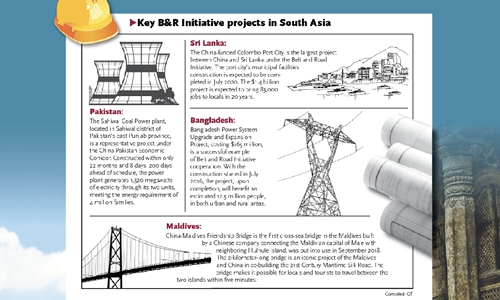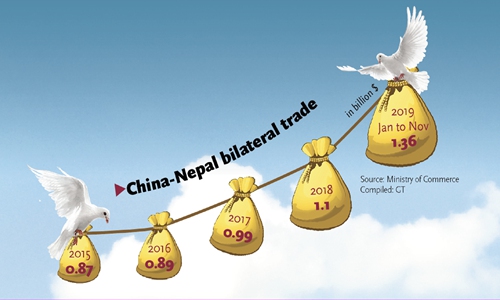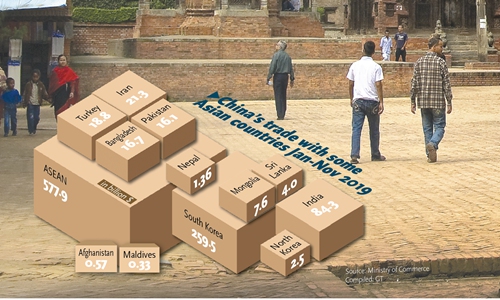HOME >> SOURCE
China-Nepal economic relations enter fruitful year
By Huang Ge and Li Xuanmin Source:Global Times Published: 2020/1/5 20:48:40
Bilateral cooperation to help reshape the economy of the landlocked Himalayan nation

Photo: VCG

Graphics: GT

Graphics: GT

Graphics: GT
The year 2020 will be the "early harvest year" for China and Nepal to implement their leaders' consensus, with economic and trade ties further developing through more cooperation on the Belt and Road Initiative (BRI), Chinese Ambassador to Nepal Hou Yanqi told the Global Times.
Hou noted that relevant departments are now focusing on relevant work and have made a lot of progress, especially in areas including a joint feasibility study of a bilateral free trade agreement, choosing the location of a China-Nepal cross-border economic cooperation zone, food import and export safety, production capacity and investment.
Chinese President Xi Jinping paid a state visit to Nepal in October 2019, during which the two sides inked about 20 agreements across a range of areas, including infrastructure, health, agriculture and tourism. It also marks the first by a Chinese leader to the Himalayan country in 23 years.
Hou said the visit has "provided systematic guarantees for both countries to further expand economic and trade cooperation in the future."
As Nepal is committed to economic transformation, the country has large demand for infrastructure in terms of railways, roads and airports and the cooperation based on the BRI has provided an important opportunity for Nepal to improve its domestic and external links, Hou said. She noted that China and Nepal are now jointly building a cross-Himalayan transportation network to help transform the "landlocked" nation into a "land-connected" nation.
In 2020, China and Nepal will continue to advance the feasibility study on a cross-border railway from Gyirong, Southwest China's Tibet Autonomous Region, to Kathmandu and to improve the function of Tibet's Zhangmu port, she said.
Zhangmu port, which was shut down due to earthquake damages in Nepal in 2015, resumed freight transportation in May 2019. The port has so far operated in a sound manner with increased freight and trade volume.
Chinese companies are also assisting in a number of "National Pride Projects" of Nepal, such as the Pokhara Regional International Airport and Gautam Buddha International Airport. The Tribhuvan International Airport in Kathmandu has thus far been the country's only international airport.
Hou added that those projects will further improve Nepal's connectivity with the globe.
Dai Yonghong, Director of the Institute of the Bay of Bengal Studies at Shenzhen University, told the Global Times on Sunday that a better basic infrastructure network will help Nepal transform its edges in tourism, agriculture and hydropower resources into key economic drivers.
"Nepal is well-positioned to unleash its potential entrepot trade economy by taking advantage of its location adjacent to the world's two largest developing economies - China and India," Dai explained.
On the one hand, the mountainous nation could serve as a gateway for Chinese goods to make inroads into South Asian markets such as India. On the other hand, as China allows Nepal to use some of its ports, the Himalayan nation could also make more goods such as herbs, fruit and carpets get access to more foreign destinations, according to analysts.
In the first 10 months of 2019, trade between China and Nepal hit $1.2 billion, up 36.1 percent year-on-year.
Dai pointed out that healthy and sound ties between China and Nepal also pave the way for an economic take-off in the South Asian region. But he stressed that Nepal needs to insulate itself from global big-power games and come up with an independent economic development strategy.
The year 2020 will see a peak of Chinese tourists visiting Nepal, Hou said. Nepal has designated 2020 as Visit Nepal Year, and it aims to attract 2 million foreign tourists, which is an ambitious step up from 2018's total of 1.17 million visits.
China is the second-largest tourism source country for Nepal and the number of Chinese tourists visiting Nepal rose 11.5 percent year-on-year to 135,000 in the first ten months of 2019, Hou said, citing data released by the Nepali authorities.
In October, President Xi made a successful state visit to Nepal as residents in Kathmandu spontaneously went into the streets and showed their warm welcome. This scene left a deep impression on the Chinese people, and more of them began to pay close attention to Nepal, hoping to enjoy the unique snowy scenery and experience its long history and culture, the ambassador noted.
RELATED ARTICLES:
Posted in: ECONOMY